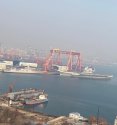If it is based at Qingdao.
Then the Kunming should had been deployed at the NSF seeing that it was then the most technologically advanced and powerful ship at the time. But it got slotted to the SSF instead. And funny you should bring up Nanchang, because if we go by that the idea that China names ship according to where they are stationed geographically then Nanchang should be stationed at the ESF due to the location of the said city.
Also China's naval aviation for carriers is less then 2 decades old so history has little to do with this.
Destroyer names have no connection to where they are deployed. After all Hohhot which is named after an Inner Mongolian city, is stationed in the SSF.
Nanchang is stationed in Qingdao, where the NSF is. It shows you how the priorities have changed since the time the Kunming was allocated.
LIkewise, when the two Type 051C were introduced, they were the most powerful air defense destroyers in the fleet, and they both went to the NSF.
The issue of the capital region only really pops up if the enemy plans for a invasion or the air force fails to deter them. Neither scenarios are possible IMO. That was how China's strategy when during the Cold War against Russia. While geopolitical the NSF area is the least likely among all 3 areas for tensions to erupt.
And SCS & Melacca straits are geographically farther from the Chinese mainland, so carrier aviation will be more crucial in that area.
Your opinion, not the CCP's. CCP should want the best assets closest its capital city.
Then why would you include that in your original post ? I would disagree with second assessment but I suggest we agree to disagree at this point.
Considering the amount of preparation that goes into the commissioning and how meticulous the ceremony was conducted. A surprise is not the Shandong's visit to Sanya, you do not spring a surprise on Xi Jinping especially one that requires him to travel the near length of the country to attend to.
Amount of preparation? The commission seemed like a rush, and only because some higher ups may have decided this change in plan because of XJP's trip to Macau and he may have already has a planned visit to the SSF.
I am more of the opinion that Shandong sounds more intimidating that Hainan and that in terms of importance and industrial might Shandong ranks higher. Hence the name, but we will have to see in the future.
This sounds nonsense.
To clarify and to rectify my original post, modern anti-growth paint is somewhat neutered due to enviromental concerns. In the past tin based paint was so effective that it kills even the surrounding microorganism, but that is Western concerns and what China thinks about it is unknown . On the flip side other navies in the area had been operating large ships for longer periods yet they are not dry docked that early into their careers. The Japan with the Izumo for one, we can agrue that helicopters and the F-35 VTOL will not require it to be functioning at top speed, but significant barnacle growth will also have a negative effect on fuel consumption.
Do you actually count or document the time they are dry docked? Yokosuka has plenty of facilities including dry docks.
Waters around cities tend to be nutrient rich, helped by human waste and sewage after all. You got dense Chinese cities which are among the most populous in the world, and you bet the waters around these cites are nutrient rich. Both Dalian and Qingdao are perfect for such spawning conditions. The north and east coast of China near the shores have reported things like massive algal and jellyfish blooms. Plenty of food for things to grow on. One time the Liaoning could not sortie, due to the massive jellyfish bloom, and orders were made to deploy fishermen to clean up the jellyfish to clear a way for the carrier.
Then you have a ship that sits on the pier much of its time, only taking short trips for trials. You got the perfect conditions for barnacle growth. You cannot use Japan's examples like Izumo because both Izuma and Kaga are constantly on the move, including patrols in the South China Seas and in the Philippine Seas. The way to reduce barnacle growth is to keep ships moving. I bet you Chinese navy ships tend to barnacle more because they tend to stay more in the bases and do shorter patrols because the force remains regionally defense oriented.
Significant barnacle growth will have an effect on the top speed of the carrier, which means it will affect its launch speed. That has an indirect effect on the load out of the J-15s it can launch and from the videos the PLAN released, not too impressive considering the previous video of the Liaoning had the planes launch with more ordinance.
The Shandong went sustained full speed in both trips in and out of the SCS with satellite photos showing she leaving her escorts behind. She could be doing take offs and landings, and testing her engines on the sustained runs. Back in the Sanya port, she was heavily circulating water to cool her power plant, which indicates she had undergone sustained running.
She's back in her Dalian dry dock, but one thing to note is that Barracks ship 89 didn't accompany her this time. This points to her stay in the dry dock is likely to be short, or Barracks ship 89 will go back to Dalian to serve as living quarters to the workers servicing the Shandong.






